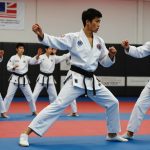Importance of Reaction Time in Badminton
Reaction time is crucial in badminton, directly influencing a player’s badminton skills. A swift reaction allows players to anticipate and swiftly counter opponents’ moves, enhancing strategic play and accuracy. Superior reaction time can make the difference in high-stakes matches, determining the outcome in fast-paced rallies.
Improving reaction time offers significant training benefits for players across all skill levels. For beginners, it aids in mastering the fundamentals, making the game more enjoyable and less overwhelming. Intermediate players benefit by gaining an edge in competitive settings, while advanced athletes can elevate their performance to professional standards.
Also to see : Empowering teens: how team sports foster mental well-being and positive psychology
Studies underscore the link between enhanced reaction time and success in badminton. Findings reveal that athletes with quicker reactions tend to perform better in tournaments, showcasing greater agility and precision. Consequently, integrating reaction-specific training into practice routines can propel players towards achieving their personal best.
Beyond performance, honing reaction time fortifies mental agility, promoting faster decision-making under pressure. As a core component of badminton skills, developing quicker reflexes through targeted exercises can vastly improve both offensive and defensive maneuvers, ensuring readiness for the sport’s challenges.
This might interest you : Enhancing your running endurance: the complete handbook for tracking heart rate variability
Tailored Workout Plans for Improving Reaction Time
Developing custom workout plans is essential for enhancing reaction time in badminton. An effective tailored training regimen focuses on specific goals, allowing players to improve personalized drills suited to their skill level.
The structure of a custom workout plan should include a mix of agility, coordination, and reflex enhancement exercises. Beginners might start with simple footwork drills to build foundational skills, while advanced players may incorporate high-intensity, complex reaction exercises like reaction ball drills. This ensures that each session is aligned with individual abilities and aspirations.
Adjusting the intensity and duration of exercises is crucial to maximising benefits. Players should consider their current fitness level when setting up their workouts. Short bursts of high-intensity drills can be more effective for advanced athletes, while longer, moderate-paced routines may suit those just starting.
Incorporating rest and recovery periods into workout plans is also key. This not only prevents fatigue but also allows the body to adapt and enhance performance over time. By personalizing each element of the plan, players can achieve a balanced and effective approach to improving their reaction time in badminton.
Drills to Enhance Reaction Time
Improving reaction time through targeted training exercises is key to excelling in badminton. Different drills provide unique benefits, ensuring players develop agility and sharpen their reflexes.
Shadow Badminton
This drill mimics actual gameplay without a shuttlecock, helping players perfect footwork and swift agility drills. By predicting opponent moves, players enhance their anticipation skills, a vital part of competitive play.
Reaction Ball Drills
Using reaction balls enhances unpredictability and speed. When a reaction ball bounces in unanticipated directions, players quickly adapt and adjust their movements. This exercise focuses on enhancing overall reflexes.
Partner Drill Exercises
Training with a partner introduces variability and adaptability. One player can randomly shuttle or softly throw another object, compelling the receiving player to adjust dynamically. This fosters real-game adjustment skills.
Incorporate these reaction drills into regular sessions to see significant improvements. Modify drill intensity and complexity according to player skills, ensuring both beginners and seasoned players can benefit. A gradual increase in pace bolsters player confidence and enhances reaction proficiency.
Instructional Videos and Resources
Accessing high-quality training videos is crucial for mastering reaction time in badminton. Credible platforms such as YouTube and specialized sports websites offer a wealth of instructional content. These resources allow players to visualize techniques and understand their execution in practical scenarios. By watching video demonstrations, players can learn the nuances of footwork, agility, and reflex enhancement exercises.
Additionally, various online resources provide step-by-step guides essential for developing badminton skills. Websites featuring expert coaches, such as Badminton World Federation’s official page, often include comprehensive tutorials focusing on improving reaction time. Players benefit by gaining insights from experienced professionals, enhancing their understanding of effective reaction drills.
Utilizing these tools not only aids in grasping proper methods but also allows for self-paced learning. Aspiring players at any skill level can follow along with expert-driven content to refine their training approaches. This integration of instructional videos into regular practice ensures a well-rounded development of reaction skills, contributing to improved overall performance in badminton. Engaging with these resources can act as a catalyst for achieving personal bests and excelling in competitive play.
Expert Tips for Maximizing Training Efficiency
To achieve excellence in badminton, integrating expert advice from seasoned players and coaches can significantly enhance your training strategies. These professionals provide insights into maintaining motivation and discipline, which are paramount for consistent progress. Incorporating performance tips ensures that each training session is purposeful and geared toward overall improvement.
Training Efficiency Tips:
- Focus on Quality: Professionals emphasize quality over quantity in practice sessions. Concentrating on executing drills with precision will yield better results than prolonged, unfocused training.
- Maintain Consistency: Regular practice is essential. Even short, daily training can lead to substantial performance growth.
The importance of recovery and rest is often highlighted in expert recommendations. Taking time for rest prevents burnout and offers the body a chance to metabolize and incorporate improvements from training. The strategic inclusion of rest days is crucial to avoid overtraining and enhance overall performance.
Ultimately, finding a balance between intense training sessions and adequate recovery periods can greatly optimize your progress. By following these expert insights, players can develop a sustainable and efficient practice regime, paving their path to badminton success.
Measuring Progress in Reaction Time
For players aiming to enhance their reaction time, effective progress tracking is essential. Employing reliable performance measurement methods provides insight into improvements and highlights areas needing attention.
Tracking Methods
-
Drill Performance: Evaluate your reaction time by conducting periodic assessment techniques through drills. These exercises test agility and speed, offering tangible data to analyze progress.
-
Technology Use: Advanced tools like apps or sensors can offer precise feedback on reaction times during training. Utilize these technologies to gather data and identify trends in your performance.
By setting realistic goals and creating benchmarks, players can systematically work towards improving reaction time. Regularly revisiting these benchmarks ensures the training remains focused and results-oriented.
Suggested Evaluation Drills
- Incorporate drills like reaction ball exercises or timed agility tests regularly. This not only sharpens skills but also aids in consistently assessing progress in reaction skills.
Players should adapt their training in response to these assessments, ensuring continuous development. Embracing a structured evaluation approach aligns efforts with personal aspirations, ultimately enhancing overall badminton performance. Understanding your advancements in reaction time is not only motivating but crucial for strategic growth in the sport.
Success Stories and Case Studies
Explore inspiring success stories and detailed case studies showcasing the transformative impact of tailored workouts on badminton performance. These real-life examples serve as testament to the effectiveness of systematic training, motivating players to advance their skills.
Notable case studies reveal how athletes have significantly improved their badminton skills through personalised regimens. One standout example involves a semi-professional player who accelerated their progress by integrating specialised reaction drills and agility exercises. By embracing these tailored approaches, they achieved notable tournament victories.
Moreover, a multitude of player testimonials highlights the journey from amateur to advanced levels. Many players attribute their success to incorporating precise agility drills and honing reaction time. These stories underline the importance of consistent practice and strategic exercise integration.
Through these narratives, aspiring badminton enthusiasts gain encouragement by recognizing the potential outcomes of dedicated training. Drawing inspiration from these success stories, players can visualize their path to improvement, using well-structured training plans as a blueprint for development. Case studies demonstrate that commitment, coupled with a strategic approach, can lead to exceptional results in the sport of badminton.











